 |
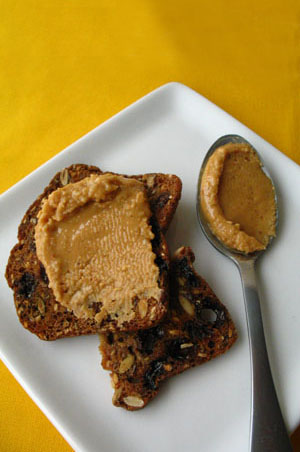 |
Pacific Beach’s flavored peanut butters are textured, airy and delicious. Here, the Toffee flavor on raisin Rainforest Crisps. Photo by Leah Hansen | THE NIBBLE. |
| WHAT IT IS: Gourmet peanut butter spread in luscious, sweet flavors. The line is gluten-free. |
| WHY IT’S DIFFERENT: It’s 25%-50% flavor elements (butterscotch, chocolate, toffee, etc)! You can eat a spoonful instead of candy or dessert. |
WHY WE LOVE IT: Fab flavors and a dreamy, “whipped” texture. The sweet flavors are just perfect for cookie sandwiches and other treats. |
| WHERE TO BUY IT: WannaSpoon.com. |
|

White Chocolate spread from Pacific Beach Peanut Butter. Photo by Elvira Kalviste | THE NIBBLE. |
|
Gourmet Peanut Butter
From Pacific Beach
Jump to the article index below
REVIEW: Like many college graduates of the recessionary years, Matthew Mulvihill faced a business world with high unemployment and limited options. After working a number of unfulfilling jobs, he decided to start a peanut butter business in the sunny land that is San Diego. The brand launched last June; the name was inspired by San Diego’s three-mile-long Pacific Beach, sandwiched between the blue ocean and a happening boardwalk.
Pacific Beach Peanut Butter Spreads are a wonderfully different approach to flavored PB.
In addition to great taste achieved from using the best ingredients (including Belgian chocolate), Pacific Beach spreads have a light and airy texture. It’s the sensation of a “whipped” peanut butter, something we haven’t experienced before.
Company founder Matthew Mulvihill, who developed the concept in his kitchen with a peanut grinder, explains why:
- Conventional Approach: Other brands make the peanut butter, then add the flavorings.
- New Approach: At Pacific Beach Peanut Butter, an ample amount of the flavor elements (chocolate, M&Ms, toffee, etc.)—representing 25% to 50% of the contents—are mixed in with the peanuts before any grinding takes place. (See the difference between peanut butter and peanut butter spread, below.)
- The Result: Because all the ingredients get ground and integrated together, the delightful texture results.
Because sweet ingredients are already mixed into the PB, no jelly is require for a sugar hit—although there’s no rule to prevent you from piling it on. The only challenge is where to begin!
Gourmet Peanut Butter Flavors
Perhaps the best way to start is to pick your passion:
- Butterscotch: Butterscotch, Caramel and Toffee spreads (the differences among the three)
- Cinnamon: CinnaYum spread (0 grams of sugar!)
- Chocolate: Child’s Play (M&Ms), Chocolate, Chocolate Raspberry, Dark Chocolate and White Chocolate spreads
- Regular PB: All Natural Peanut Butter (regular or unsalted)
The line is gluten-free.
You can buy individual jars, gift boxes with three or four flavors of your choice, and gift certificates. Individual jars are $9.00, with price breaks for larger quantities.
The Difference Between Peanut Butter
& Peanut Butter Spread
By law, peanut butter must contain at least 90% percent peanuts. Other flavored peanut butters can achieve this.
Pacific Beach flavored peanut butter spreads contain between 50% and 75% peanuts, depending on the flavor. The rest is just chock full of yummy flavor elements.
The review continues below, with ways to use flavored PB.
Also check out the article index, below.
|
| |
|
|
Recipes With Peanut Butter
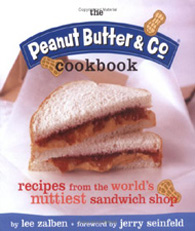 |
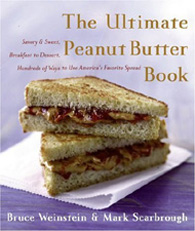 |
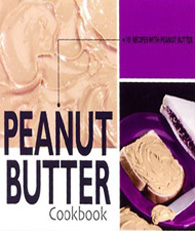 |
Peanut Butter & Co. Cookbook, by Lee Zalben. More than 80 gooey recipes for everything from decadent desserts (Four-Layer Peanut Butter–Honey Cake) to delicious, nutritious snacks (Baked Apples with Peanut Butter) and sensational entrees (Peanut Butter Pad Thai). More information.
|
The Ultimate Peanut Butter Book: Savory and Sweet, Breakfast to Dessert, Hundreds of Ways to Use America's Favorite Spread, by Bruce Weinstein and Mark Scarbrough. From sticky buns to cheesecake to Elvis Spread, go way beyond the same old PB&J. More information.
|
Peanut Butter Cookbook: 101 Deliciously Nutty And Fun Recipes, by G & R Publishing. Kid-friendly recipes include mains and sides, plus 82 desserts and sweets, including Butterscotch-Peanut Fudge, Cheerios Treats and Peanut Butter Easter Eggs. More information.
|
INDEX OF REVIEW
This is Page 1 of a one-page review. Click on the black links to visit other articles:
|
MORE TO DISCOVER
|
Beyond A Bread Spread
Peanut butter enthusiasts know that there’s more to using PB as a bread spread or spoon candy.
- On Oatmeal, Pancakes & Waffles. Add a dab from the jar, or make it into a sauce by adding a bit of vegetable oil (heating helps, too).
- Atop A Cookie. Delightful on chocolate wafer cookies, graham crackers and tea biscuits.
- As A Fondue. Heat the jar or serving plate in the microwave until the PB is warm; then dip apple slices, bananas, strawberries, cookies and crackers.
- As A Dessert Topping. Heat the jar in the microwave until the PB is warm; then use to top ice cream, angel cake or pound cake.
- As Spoon Candy. Just as dipping into a jar of fudge sauce can satisfy a chocolate jones, Pacific Beach PB spreads replace the peanut butter cup or other peanutty candy.
|
|
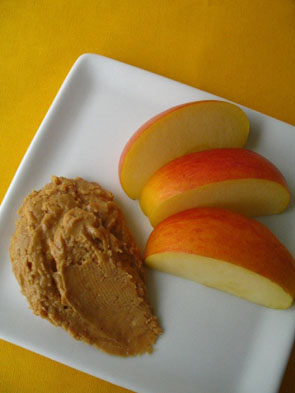 The Caramel flavor with apple slices: inspired! Lady Alice apple from RainierFruit.com. Photo by Leah Hansen | THE NIBBLE. The Caramel flavor with apple slices: inspired! Lady Alice apple from RainierFruit.com. Photo by Leah Hansen | THE NIBBLE.
|
This is great “gift peanut butter.” So treat yourself and someone special.
— Karen Hochman FOOD TRIVIA: While the name says “nut,” peanuts are in fact legumes, like beans and peas. Peanuts grow underground, as opposed to tree nuts like almonds and walnuts. Both nuts and legumes are members of the same botanical family, Leguminosae, but are of different genuses. The growing cycle takes four to five months, depending on the type or variety. In the U.S., peanuts and peanut butter are the most popular nut choice, comprising 67% of all nut consumption. Peanuts originated in South America and became part of the archeological record dating to 950 B.C.E. Incas used peanuts and made it into a paste, although not like modern peanut butter. Transported to America, peanuts were first grown commercially in Virginia in the 1800s.
Do you have friends who would enjoy THE NIBBLE?
Click here to send them an invitation to sign up for their own copy. |
© Copyright 2004-2025 Lifestyle Direct, Inc. All rights
reserved. All information contained herein is subject to change at any time
without notice. All details must be directly confirmed with manufacturers, service
establishments and other third parties. The material in this e-zine may not
be reproduced, distributed, transmitted, cached, or otherwise used, except with
the prior written permission of Lifestyle Direct, Inc.
|
|

|
 |